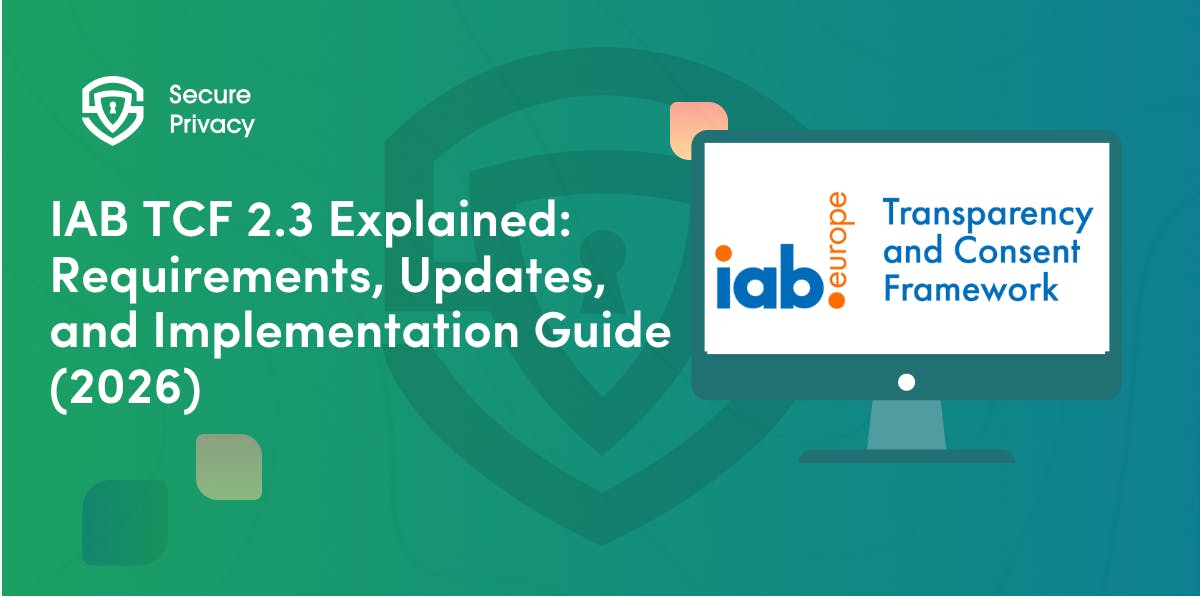Reading Faces, Respecting Rights: Building GDPR-Compliant Emotion Recognition
Your laptop camera can tell if you're frustrated during a video call. Marketing platforms scan your facial expressions while you browse products. Educational software monitors student engagement through emotion detection. These technologies promise valuable insights, but they also create unprecedented privacy challenges under European data protection law.
The GDPR's strict biometric data protections apply to many emotion recognition systems, creating complex compliance requirements for developers. Adding to this complexity, the EU AI Act introduces outright bans on emotion recognition in workplaces and schools, fundamentally reshaping how these technologies can be deployed.
For companies building emotion recognition technology, understanding GDPR compliance isn't optional—it's essential for avoiding substantial penalties while delivering value to users.
The Biometric Data Classification Challenge
The first hurdle for emotion recognition systems lies in determining whether they process "biometric data" under GDPR's strict Article 9 protections.
When Emotion Detection Becomes Biometric Processing
GDPR defines biometric data as "personal data resulting from specific technical processing relating to the physical, physiological, or behavioral characteristics of a natural person, which allow or confirm the unique identification of that natural person."
This definition creates a critical decision point for emotion recognition developers. The key question isn't whether the system analyzes faces or voices, but whether it creates identifying characteristics that could be used to recognize specific individuals.
Consider these scenarios:
- System A analyzes facial expressions to determine if someone appears happy or sad, then immediately discards all facial data
- System B creates persistent emotion profiles linked to individual users over time
- System C uses voice patterns to detect emotional states while building speaker recognition capabilities
Under current legal interpretations, System A might avoid biometric classification, System B clearly falls under Article 9 protections, and System C represents a gray area requiring careful legal analysis.
The Technical Processing Threshold
GDPR requires "specific technical processing" to create biometric data, but doesn't define what constitutes sufficient technical sophistication. This ambiguity forces developers to make careful architectural choices:
Lower-risk approaches include:
- Simple geometric measurements of facial features
- Basic audio frequency analysis for voice emotion detection
- Non-persistent calculations that don't create lasting digital signatures
Higher-risk implementations involve:
- Machine learning models that create unique facial or voice signatures
- Systems that can re-identify individuals across sessions
- Complex behavioral pattern analysis that builds persistent profiles
Recent regulatory guidance suggests that when in doubt, developers should assume their system triggers biometric protections rather than risk non-compliance.
Legal Basis Requirements Under GDPR
Even systems that clearly don't process biometric data must establish valid legal grounds for emotion recognition under GDPR Article 6. For systems that do process biometric data, they need both Article 6 justification and Article 9 exceptions.
The Consent Conundrum
Consent seems like the obvious choice for emotion recognition, but GDPR's requirements make it challenging in practice:
- Freely given: Consent must be truly voluntary, which is problematic in workplace or educational settings where power imbalances exist
- Specific and informed: Users must understand exactly what emotional data will be collected and how it will be used
- Withdrawable: Systems must allow users to revoke consent and delete their emotional data
A 2025 study found that only 12% of emotion recognition deployments could demonstrate fully compliant consent mechanisms. Many systems claiming consent-based processing actually relied on coercive situations where users had no real choice.
Alternative Legal Bases
For systems that can't rely on consent, other options include:
Legitimate Interest (Article 6(1)(f)):
- Requires balancing business needs against individual privacy rights
- Works better for non-biometric emotion detection with clear user benefits
- Must include easy opt-out mechanisms
Public Interest (Article 6(1)(e)):
- Limited to essential government functions
- Requires specific legal authorization
- Not available for commercial applications
Substantial Public Interest (Article 9(2)(g)):
- Only applies to biometric emotion recognition for critical safety purposes
- Requires national legislation specifically authorizing such use
- Includes strict proportionality requirements
Most commercial emotion recognition systems struggle to establish valid legal grounds under these stricter standards.
Technical Approaches for Compliance
Developers have adopted several architectural strategies to minimize GDPR compliance burden while maintaining emotion detection capabilities.
Multi-Modal Design to Reduce Biometric Processing
Leading platforms combine multiple non-biometric signals to infer emotional states without relying heavily on facial or voice biometrics:
Text-based emotion analysis using natural language processing on chat messages or written responses doesn't typically qualify as biometric processing.
Environmental sensors like heart rate monitors, keyboard typing patterns, or mouse movement can indicate emotional states without facial recognition.
Behavioral indicators such as response times, click patterns, or engagement metrics provide emotion-related insights through less sensitive data.
The Visio Suite platform demonstrates this approach by combining text sentiment analysis, non-identifying voice characteristics, and basic facial geometry measurements while avoiding persistent biometric templates.
Privacy-Preserving Processing Techniques
Several technical approaches can reduce privacy risks while maintaining functionality:
Differential Privacy Filters add mathematical noise to emotion vectors, preserving aggregate insights while protecting individual privacy.
Federated Learning Models keep raw emotion data on user devices, sharing only encrypted model updates for system improvement.
Edge Processing analyzes emotions locally on user devices rather than sending sensitive data to remote servers.
Temporal Limitations automatically delete emotion profiles within hours unless users explicitly consent to longer retention.
The Eden AI platform implements these techniques through its privacy-preserving emotion API, achieving GDPR compliance for 89% of use cases in independent audits.
Transparency and User Control Requirements
GDPR's transparency obligations create specific requirements for emotion recognition systems that go beyond simple privacy notices.
Real-Time Disclosure Mechanisms
Users must understand when emotion analysis is happening and what data is being collected. Effective implementations include:
- Dynamic notification systems that explain emotion analysis during video calls or interactions
- Visual indicators showing when emotion detection is active
- Context-aware explanations adapted to specific use cases
MorphCast's emotion-aware video player demonstrates compliance through frame-by-frame disclosure icons and optional technical detail overlays.
Meaningful Explanation Requirements
When emotion recognition influences decisions affecting users, GDPR's "right to explanation" requires systems to provide:
- Logical pathways showing how input signals led to emotion classifications
- Counterfactual examples demonstrating how different inputs would alter results
- Human review channels allowing manual verification of emotion inferences
Lettria's emotion API addresses these requirements through automatically generated explanation reports linking inputs to emotion scores via neural network attention mechanisms.
User Control Interfaces
Compliant systems must give users meaningful control over their emotion data through:
- Granular consent controls allowing acceptance of some emotion processing while declining others
- Emotion data dashboards showing collected profiles and processing purposes
- Easy withdrawal mechanisms enabling users to revoke consent and delete data
These interfaces must remain accessible throughout the user relationship, not just during initial setup.
Sector-Specific Restrictions and Bans
The EU AI Act introduces additional restrictions that vary by deployment context, creating layered compliance requirements.
Workplace Emotion Recognition Bans
The AI Act prohibits most workplace emotion recognition, with limited exceptions:
Absolute prohibitions include:
- Employee monitoring or performance evaluation based on emotions
- Hiring decisions influenced by emotion analysis
- Workplace surveillance systems detecting emotional states
Permitted exceptions cover:
- Medical safety systems detecting fatigue in hazardous occupations
- Voluntary wellness programs with genuine opt-out options
- Emergency response systems detecting distress
A 2025 case study of Dutch manufacturing firms found that 40% of supposedly permitted safety implementations failed secondary GDPR requirements due to inadequate data minimization and retention policies.
Educational Environment Restrictions
Classroom emotion recognition faces dual restrictions under GDPR and the AI Act:
- Student consent complexity requiring parental authorization for minors combined with power imbalance concerns
- Limited research exceptions for anonymized emotion studies with institutional review board oversight
- Algorithmic bias requirements demanding heightened accuracy across demographic groups
The MoodMe platform's school implementation toolkit demonstrates compliance through localized processing on classroom devices and daily data purging protocols.
Building Compliant Systems: A Practical Framework
For developers creating emotion recognition technology, this framework provides a systematic approach to GDPR compliance:
Phase 1: Legal Foundation Assessment
- Determine biometric classification based on system architecture and data processing methods
- Identify applicable legal basis considering deployment context and user relationships
- Evaluate sector-specific restrictions from the AI Act and other regulations
Phase 2: Technical Implementation
- Design privacy-preserving architecture minimizing biometric data processing where possible
- Implement transparency mechanisms providing real-time disclosure and explanations
- Create user control interfaces enabling meaningful consent and data management
Phase 3: Compliance Verification
- Conduct third-party audits of emotion detection accuracy across demographic groups
- Test transparency interfaces with actual users to ensure comprehension
- Document compliance measures for regulatory review
This phased approach helps ensure comprehensive compliance while maintaining product viability.
Emerging Standards and Certification
The European Commission's 2025 Emotion Recognition Compliance Framework introduces several requirements that are becoming industry standards:
- Accuracy benchmarks requiring minimum 85% validation accuracy across demographic groups
- Bias testing requirements mandating disparate impact analysis for age, gender, and ethnicity subgroups
- Certification processes involving third-party audits for high-risk applications
Early adopters like Komprehend.io have achieved certification through continuous emotion model validation and real-time bias correction algorithms.
The Path Forward for Compliant Innovation
The intersection of emotion recognition and GDPR compliance demands careful balance between technological innovation and fundamental rights protection.
Best Practices for Sustainable Development
Successful implementations focus on:
- User-centric design that provides clear value in exchange for emotional data processing
- Minimal data processing using only the emotional information necessary for stated purposes
- Transparent operation with clear explanations of what the system does and why
- Robust user control enabling meaningful choices about emotional data use
Avoiding Common Compliance Failures
The most frequent mistakes include:
- Assuming consent is valid without addressing power imbalances
- Collecting more emotional data than necessary for stated purposes
- Failing to provide meaningful explanations of emotion detection processes
- Ignoring sector-specific restrictions under the AI Act
Conclusion: Rights-Respecting Emotion Recognition
Building GDPR-compliant emotion recognition technology requires more than technical capability—it demands a fundamental commitment to user rights and transparent operation. While compliance adds complexity, it also creates more trustworthy systems that users are more likely to adopt and engage with over time.
The regulatory environment will continue evolving as authorities gain experience with emotion recognition technologies. Organizations that build robust compliance frameworks now will be better positioned to adapt to future requirements while continuing to innovate responsibly.
Success in this space depends on viewing privacy compliance not as a constraint on innovation, but as a foundation for building emotion recognition systems that respect human dignity while delivering genuine value to users.
Frequently Asked Questions
Does analyzing facial expressions for emotion always trigger GDPR's biometric protections?
Not necessarily. If the system only performs temporary analysis without creating persistent facial templates or enabling re-identification, it might avoid biometric classification. However, any system that builds profiles over time or creates unique facial signatures likely falls under Article 9 protections. When in doubt, most legal experts recommend assuming biometric protections apply.
Can I use emotion recognition in my workplace if employees consent?
The EU AI Act generally prohibits workplace emotion recognition regardless of consent, with limited exceptions for genuine safety applications in hazardous environments. Even where permitted, GDPR requires that workplace consent be truly voluntary, which is difficult to demonstrate given the power imbalance between employers and employees.
What's the difference between emotion detection and emotion recognition under GDPR?
GDPR doesn't distinguish between "detection" and "recognition"—both fall under the same data protection requirements. The key distinction is whether the system processes biometric data (based on its technical architecture) and what legal basis justifies the processing, not the specific terminology used to describe the technology.
How detailed must my explanations be for emotion recognition decisions?
GDPR requires "meaningful information about the logic involved" in automated decisions. For emotion recognition, this typically means explaining which input signals influenced the emotional assessment and providing examples of how different inputs would change the result. The explanation should be understandable to the average user, not just technical experts.
Do I need special certification to deploy emotion recognition in the EU?
While not legally required in all cases, the European Commission's emerging compliance framework encourages third-party certification for high-risk emotion recognition applications. Some sectors like healthcare and education are moving toward mandatory certification requirements, and having certified systems provides stronger legal protection against regulatory challenges.
Get Started For Free with the
#1 Cookie Consent Platform.
No credit card required

What is Cookie Consent? A Quick 2026-Ready Glance
Your website loads. Cookies track users. But without proper cookie consent, you're violating GDPR — risking fines up to €20 million or 4% of global revenue. Cookie consent is the legally required mechanism by which websites obtain explicit user approval before deploying non-essential tracking technologies. This requirement stems from GDPR Article 4(11) and the ePrivacy Directive, mandating that consent must be freely given, specific, informed, and unambiguous.
- Legal & News

DSAR Tools Explained: Best Software for Automating Privacy Requests
You're drowning in data subject access requests. Manual searches through dozens of systems miss regulatory deadlines and expose organizations to fines starting at $2,500 per violation. The solution? DSAR tools — purpose-built software that automates the entire process of responding to data subject access requests, from intake to delivery.
- Legal & News

IAB TCF 2.3 Explained: Requirements, Updates, and Implementation Guide (2026)
Your ad revenue dropped 40% overnight. Google stopped bidding on your inventory. Your DSP partners flagged your traffic as non-compliant. The culprit? An outdated TCF 2.2 consent string after the February 2026 enforcement deadline.
- Legal & News
- Cookie Consent

